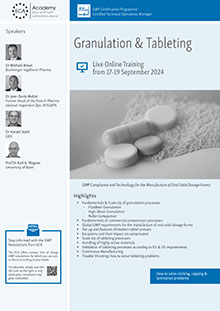WHO publishes revised draft on the Guideline on "Hold Time" studies

Recommendation
17-19 September 2024
GMP Compliance and Technology for the Manufacture of Oral Solid Dosage Forms
The key message of the Guideline has remained unchanged: manufacture in compliance with GMP requires the definition of hold times for intermediates and bulk products. The scope stated is the manufacture of solid dosage forms but it can also be applied to liquids and semi-solid dosage forms. Manufacturing of active pharmaceutical ingredients is excluded explicitly, sterile dosage forms aren't mentioned. The paper's aim is to refer to aspects that have to be taken into consideration when designing hold time studies. In most cases reference is made to intermediates and bulk products for which it should be guaranteed that they remain of appropriate quality even with hold times. But at one point reference is also made to raw materials and packaging materials.
Data to justify the hold times scientifically can be collected during development, on pilot scale or validation batches but also from information gained from an investigation of a deviation. Typically, data of one batch are taken for this. Otherwise, a risk-based approach is used to determine the appropriate number of batches to be tested. Hold times should normally be determined prior to marketing of a product. However, for products already marketed there is the possibility of retrospective risk-based, hold-time determination. For carrying out the study, the material to be tested should be kept in either the original or simulated container used in production. If the headspace plays a role the material to be tested should be stored with the maximum possible headspace. The data received should be evaluated by statistical means in order to recognise trends and to be able to establish limits. It is not necessary to carry on the study until the pre-defined acceptance criteria are exceeded. One paragraph in revision 2 that proposes a "most probable" approach opposed to a "worst case approach" or a combination of both for the design of the studies is a little nebulous.
The Guideline also contains a list of examples with the maximum hold times for the different stages of the tablet production that do not necessitate hold times (such as 2 - 30 day for the granulate). But this is a slight contradiction to the preceeding pages which require investigational studies for the determination of hold times. The paragraph providing information on cumulative hold times also is new. Generally, a cumulative hold time of 90 days is acceptable without further data being required. In the case where cumulative hold times individually add to >90 days, but there is an additional provision that time from dispensing of the ingredients to the final top coating will not exceed 30 days, further justification of the cumulative hold time is considered unnecessary.
You can find revision 2 of the draft guideline in the ECA Members' Area.
Related GMP News
GMP Conferences by Topics
- General Quality Assurance and GMP Compliance Topics
- Hygiene
- General Microbiology Topics
- Regulatory Affairs
- Development
- General Analytics Topics
- Good Distribution Practice
- Sterile Manufacturing
- Computer Validation
- General Qualification/Validation Topics
- General Engineering Topics
- APIs/Excipients
- GMP Basic Training Courses
- Medical Devices and Combination Products
- Packaging and Packaging Material
- Data Integrity
- Qualified Person (QP)
- GMP Auditing
- Documentation
- Cleaning Validation
- General IT Compliance Topics
- Impurities
- OOS / OOE / OOT
- Material Testing
- Validation of Analytical Methods
- Analytical Instrument Qualification
- Stability Testing
- Microbiological Testing
- Technology
- General Manufacturing Topics
- Solid Dosage Forms/Semi-Solid Dosage Forms
- Biotechnology/Blood/ATMP
- Herbal Drug Products/Cannabis/Radiopharmaceuticals
- Others




